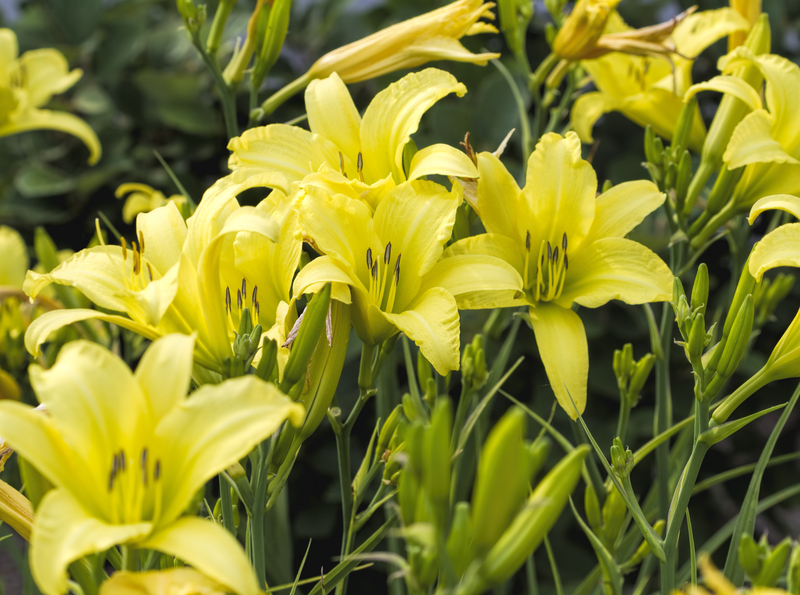Design a Harmonious Zen Sanctuary in Your Backyard
Posted on 11/06/2025
Design a Harmonious Zen Sanctuary in Your Backyard
Are you longing for a peaceful retreat right outside your home? Designing a harmonious Zen sanctuary in your backyard can create an oasis of serenity, calm, and mindfulness. A Zen-inspired garden is more than just a place to relax; it is a nurturing environment that fosters reflection, balance, and a deep connection to nature.

Why Design a Zen Sanctuary in Your Backyard?
A harmoniously designed Zen sanctuary in your backyard offers a plethora of benefits:
- Stress Relief: The gentle sound of water, soft moss, and carefully raked gravel stimulate the senses and evoke tranquility.
- Improved Focus: Mindful design promotes contemplation and enhances your ability to concentrate.
- Enhanced Aesthetics: Zen gardens are minimalist beauties that elevate the ambiance of any outdoor space.
- Connection to Nature: Harmonizing your backyard with natural elements fosters well-being and environmental appreciation.
Understanding Zen Sanctuary Principles
Before starting, it's important to grasp the essence of Zen garden design:
- Simplicity (Kanso): Minimalism is at the heart of Zen. Remove clutter and choose elements that evoke peace.
- Naturalness (Shizen): Use organic shapes and materials to echo untouched nature.
- Asymmetry (Fukinsei): Beauty is often found in imbalance, reflecting the unpredictability of nature.
- Balance and Harmony: Every element should feel like it belongs. Design your Zen sanctuary for visual and energetic equilibrium.
- Seclusion: Create a sense of privacy and intimacy, making your retreat feel like a hidden gem.
Planning Your Zen-Inspired Garden
Assess Your Backyard Space
Begin by evaluating the available area. Whether you have a sprawling lawn or a modest corner, a harmonious Zen backyard retreat can fit any size. Take note of sunlight, shade, uneven surfaces, and existing plants.
Envision Your Tranquil Retreat
Sketch a rough layout. Identify zones for different elements--such as a meditation nook, water feature, and pathways. Consider the journey through your retreat, designing for curiosity and discovery.
Essential Elements of a Harmonious Zen Sanctuary
1. The Zen Garden Core: Sand & Gravel
A central feature of many Zen gardens is the use of sand or gravel, traditionally raked to represent rippling water. This minimalist landscape forms the sanctuary's heart.
- Choose fine, light-colored gravel or crushed granite for a soothing visual base.
- Rake patterns carefully to symbolize water flow and embrace the art of Yin and Yang.
- Keep the design adaptable, allowing for mindful re-raking as a meditative practice.
2. Stones & Boulders: Anchoring Calmness
Strategically placed stones embody mountains, islands, or stepping stones to enlightenment.
- Select natural rocks of varied sizes for authenticity and interest.
- Anchor stones partially into the earth for stability and to mimic natural landscapes.
- Group stones in odd numbers (three or five) for asymmetry and visual appeal.
3. Water Features: The Essence of Flow
Add a gentle water element to your peaceful backyard sanctuary to evoke tranquility and rejuvenation.
- Koi Ponds: Foster life and movement with vibrant koi and lush aquatic plants.
- Bamboo Fountains (Shishi Odoshi): The rhythmic sound of water striking bamboo soothes the senses.
- Still Water Bowls: Reflect the sky, offering calming visual focus.
4. Lush Greenery: Connection to Nature
Carefully chosen plants infuse your Zen-inspired backyard with life, fragrance, and color.
- Mosses and Groundcovers: Create a soft carpet for contemplation areas.
- Bamboo: Symbolizes strength and flexibility; it also offers natural screening for privacy.
- Japanese Maples: Their delicate leaves add texture and seasonal color transitions.
- Ferns, hostas, and evergreens: Provide verdant year-round beauty.
5. Pathways: Mindful Journeys
Zen pathways (roji) invite deliberate, slow movement through the yard, enhancing mindfulness.
- Stepping Stones: Guide the visitor, encourage slow navigation, and become focal points.
- Gravel Paths: Offer a soft crunch with every footstep, fostering sensory immersion.
- Meditation Benches: Place simple, natural benches or stone slabs in quiet corners for seating.
6. Minimalist Structures: Architecture in Harmony
Consider subtle structures that blend with nature and support relaxation in your Zen sanctuary:
- Pergolas or Arbors: Constructed from natural wood, these provide partial shade and define space.
- Garden Gates: Symbolize the threshold between the external world and your sanctuary.
- Tea Houses or Gazebos: If space allows, these serve as contemplative studios for tea ceremonies or journaling.
The Art of Zen Garden Lighting
Gently illuminating your backyard promotes an ethereal ambiance after sunset. Opt for:
- Solar-Powered Lanterns: Eco-friendly and easy to incorporate along paths or around water features.
- Stone Lanterns (Toro): Classic symbols of enlightenment, these add an authentic touch.
- Hidden Uplighting: Highlight trees or specimen rocks for soft, mystical effects.
Tips for Maintaining a Zen Sanctuary
- Regular Raking: Rake sand or gravel lines often, rotating patterns to suit your mood and deepen your mindfulness practice.
- Pruning: Maintain shapes of trees, shrubs, and groundcovers for clarity and discipline.
- Weed Control: Remove intrusive plants to preserve the minimalist spirit.
- Seasonal Renewal: Refresh structural elements, replace damaged features, and rotate potted arrangements.
The Mindful Experience: How to Use Your Backyard Zen Retreat
Once your sanctuary is complete, immerse yourself in its benefits:
- Meditation: Start your day with guided or silent meditation sessions in your tranquil haven.
- Yoga: Practice gentle stretches or mindful yoga flows on mossy lawns or wooden decks.
- Tea Rituals: Prepare matcha or herbal tea to enjoy the art of presence.
- Reading & Journaling: Use your retreat to nourish your mind with favorite books, or capture inspiration in a peaceful journal.
- Contemplative Walks: Slowly meander along designed paths, allowing attention to settle on each step and element.
Eco-Friendly and Sustainable Zen Garden Ideas
Cultivating an environmentally conscious Zen backyard sanctuary ensures harmony with the planet as well as your soul.
- Choose local, drought-resistant plants to reduce water consumption and maintenance.
- Install a rainwater basin or barrel, using the collected water for your plants and water features.
- Source stones and wood locally to minimize carbon footprint.
- Repurpose aged materials or use reclaimed stone for stepping paths and benches.
- Compost organic debris to return nutrients to your soil naturally.
Design Inspiration: Zen Sanctuary Styles
Traditional Japanese Zen Garden
Capture classic themes with raked gravel, moss islands, and a simple bamboo water fountain. Add a stone lantern and a small wooden bridge to complete the look.
Modern Minimal Zen Sanctuary
Blend crisp architectural lines with minimalist plantings and polished stone. Incorporate sleek water features and concrete seating for a quietly contemporary vibe.
Woodland Zen Retreat
Nestle your sanctuary amongst existing trees, enhance with ferns and shade-loving plants, and use rustic logs as benches for an organic, woodland feel.
Common Mistakes and How to Avoid Them
- Overcrowding with Plants or Decor: Zen sanctuaries thrive on "less is more." Select elements mindfully.
- Ignoring Maintenance: Consistent care is essential. Allocate time weekly to keep your haven pristine.
- Forgetting Flow: Design purposeful paths; avoid abrupt stops or dead ends.
- Overusing Color: Stick to subtle, natural hues. Use color as an accent--not the main feature.
- Neglecting Seating: Create inviting spots to pause, meditate, or observe.
Frequently Asked Questions About Backyard Zen Sanctuaries
1. How much space do I need to create a Zen sanctuary?
A Zen oasis can flourish in any size--whether a small balcony or a sprawling yard. Design within your available space, focusing on simplicity and intention.
2. Is a Zen garden high maintenance?
No, but regular maintenance is key. Raking, pruning, and occasional cleaning are usually adequate. Automation, like solar-powered lighting or timed water features, can streamline upkeep.
3. Can I incorporate modern elements into my Zen sanctuary?
Absolutely! Blend traditional Zen materials (like bamboo or stone) with sleek lines, sculptural seating, or contemporary water features for a personalized touch.

Start Your Journey: Transform Your Backyard Into a Zen Sanctuary
Creating a harmonious Zen sanctuary in your backyard is a rewarding journey--a practice in itself. Allow your vision to unfurl slowly, with patience and care, as you curate each element for peace and intention. With thoughtful design, your garden can become more than a landscape; it will be a living invitation to slow down, breathe deeply, and reconnect with the present moment.
Ready to get started? Begin with a single corner and let your Zen-inspired haven blossom--one stone, plant, and breath at a time.
Summary: Embrace Tranquility and Harmony at Home
From raked gravel and mossy tranquility to peaceful water features and mindful seating, designing a Zen-inspired backyard sanctuary is about the harmony of natural elements and simplicity. By understanding Zen principles, pacing yourself through the planning and planting process, and honoring both tradition and personal taste, you can craft a tranquil retreat that provides ongoing joy, renewal, and balance right at home.
Reconnect, reflect, and rejuvenate in your handcrafted Zen sanctuary--you deserve the peace it brings.

